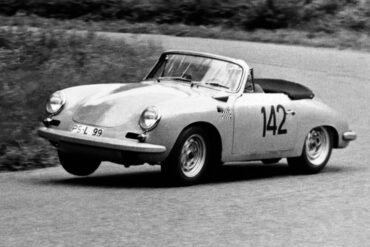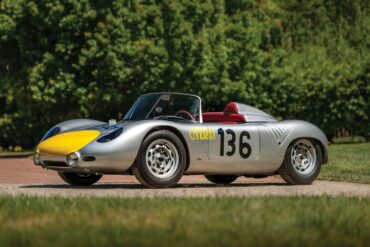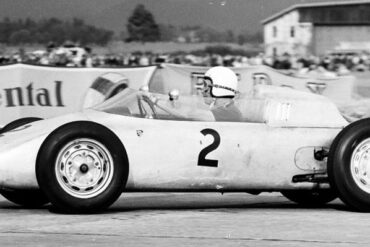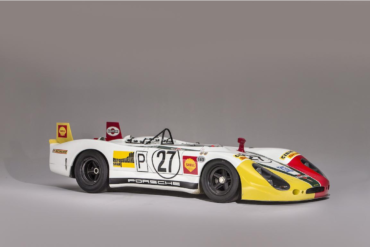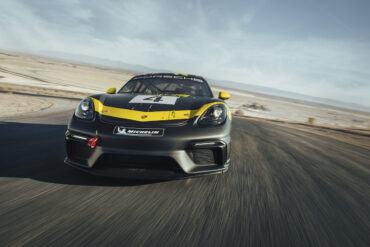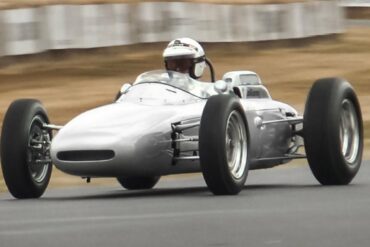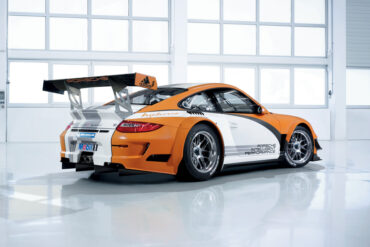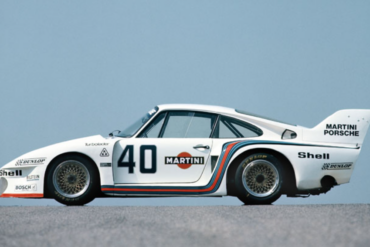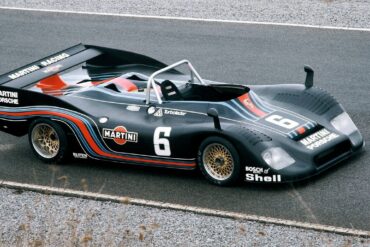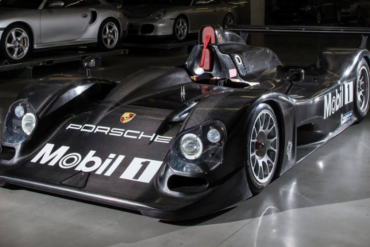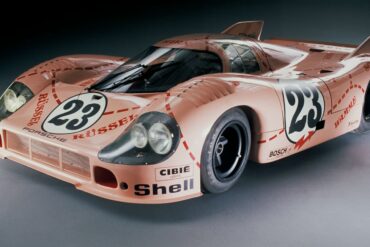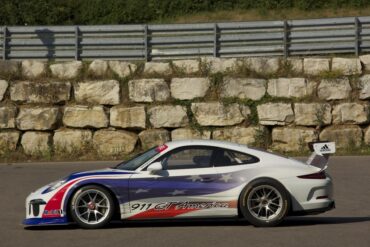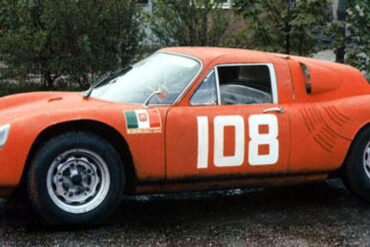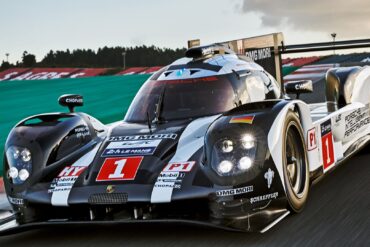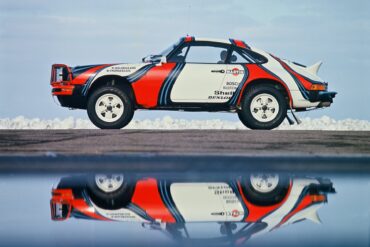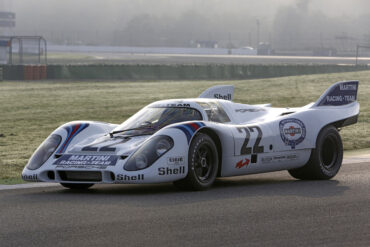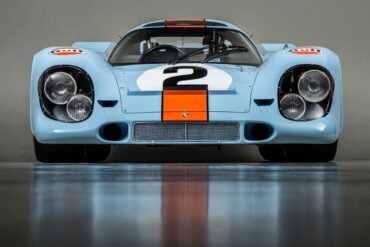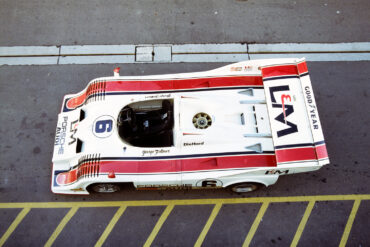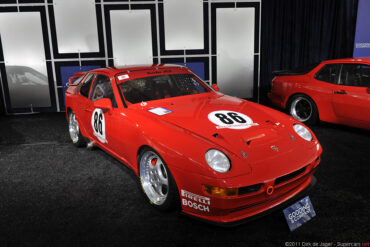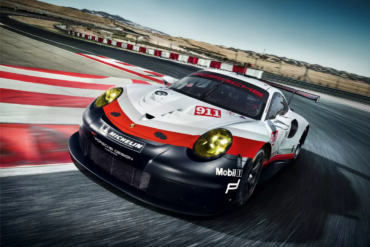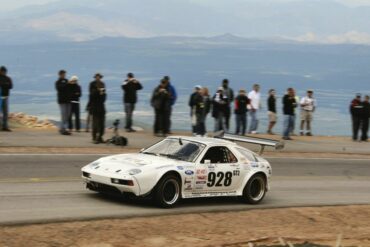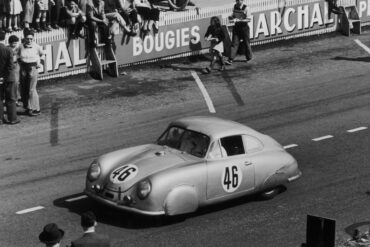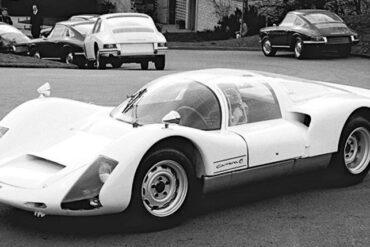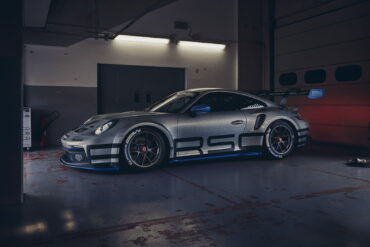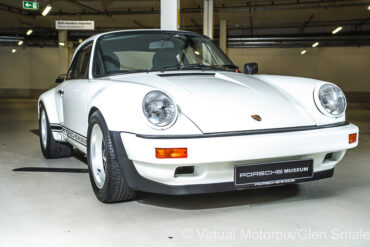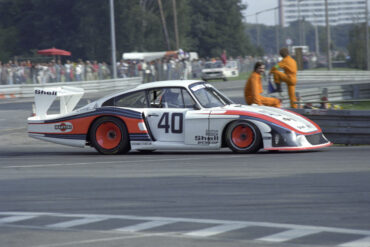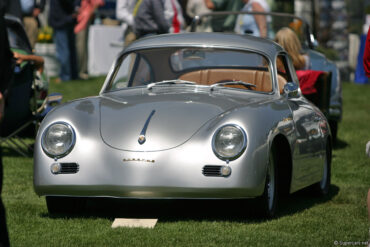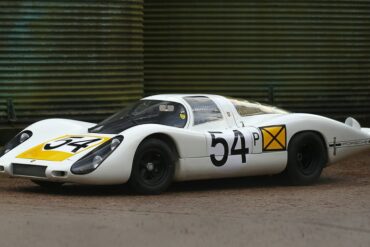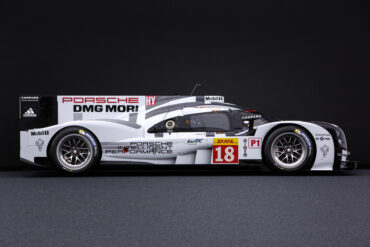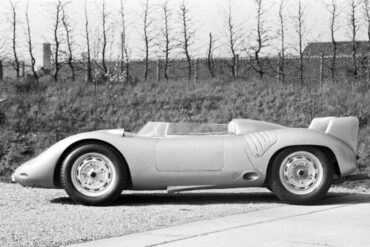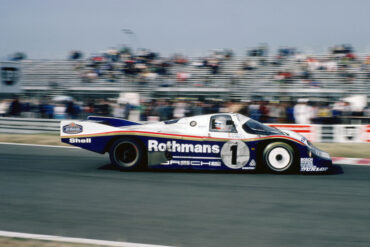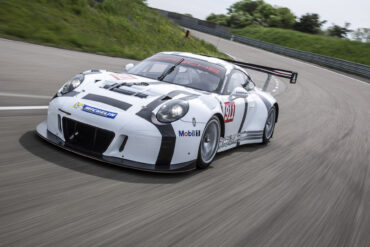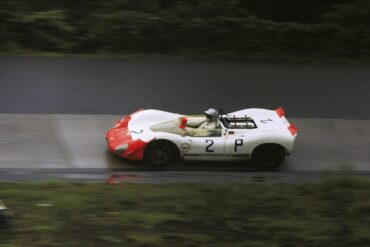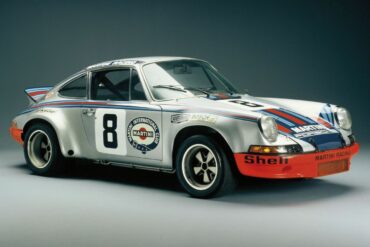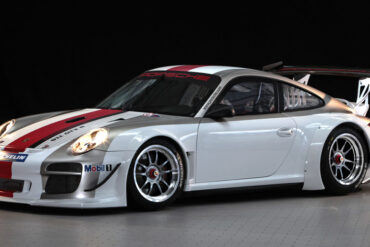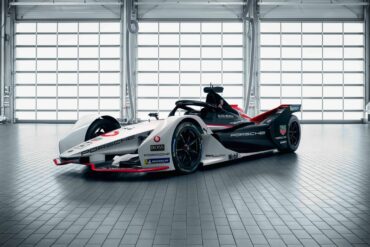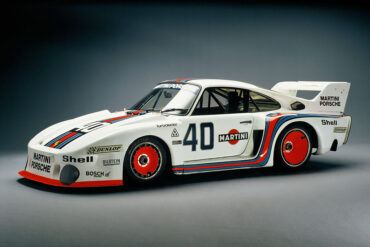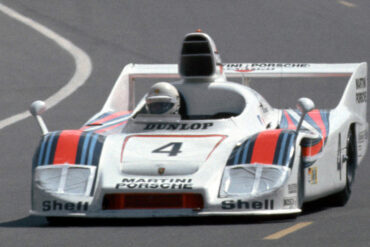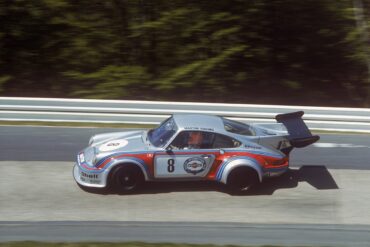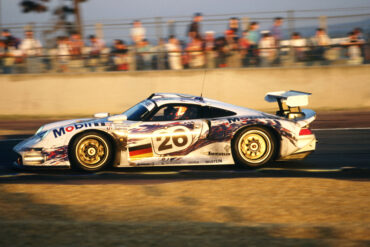As with the earlier versions, the Carrera was offered both in a Carrera GT Deluxe version for the road and the Carrera GT for racetrack duties. Unlike these earlier models, the new car benefited from the 2.0 liter engine introduced as the Carrera 2 was unveiled in September 1962. The 2.0 Carrera used a variant of the Type 547 engine with a larger bore and stoke, having 1966cc.
For the 1960 season the FIA made changes to the regulation regarding the windscreen and cockpit size. These rules changes together with a larger (1.6-litre) Type 547/3 engine, developing 160 horsepower (120 kW) and a new double wishbone rear suspension brought about the RS 60 model. The RS 60 brought Porsche victory at the 1960 12 Hours of Sebring with a car driven by Hans Herrmann and Olivier Gendebien. 1960 also saw Porsche win the Targa Florio with Hans Herrmann being joined on the winner podium by Jo Bonnier and Graham Hill. z
The fifth and the last of the 718/2 F2 cars, with chassis number 718/2-05 was an experimental formula racing car. It had the 718/2 chassis, but a different body. The car never got its own type number. It was a one-off car, continuous development project that later evolved into something that became the prototype for the 1961 Porsche 787 F1 car and then even for the 1962 Porsche 804 F1 car. 718/2-05, was first seen at the F2 race on Solitude race track near Stuttgart in July 1960.
The longer tail 908 Spyders were created only with the Flunder body - the body that's upper surface is almost flat between the axles - and not with the "normal" curvy Spyder body. Very few LH Flunders were created, both with 908/02 and 908/01 chassis numbers. 908 LH Flunder Spyder was first used at the 1969 Le Mans 24h race by Jo Siffert and Brian Redman, but they had to retire because of the gearbox failure. The only excellent result was 3rda at the 1970 Le Mans.
On 3 January 2019 the 718 Cayman GT4 Clubsport was unveiled in two variants, Competition and Trackday, with first customer cars delivered to customer teams ahead of the 2019 Roar Before the Rolex 24 Hours at Daytona International Speedway. The race car is powered by a 3.8-litre naturally-aspirated flat-six engine producing 425 PS (419 bhp; 313 kW) at 7,500 rpm and 425 N⋅m (313 lb⋅ft) at 6,600 rpm connected to a 6-speed PDK gearbox. The kerb weight is 1,320 kg (2,910 lb). Both variants feature a welded-in roll cage, a six-point harness and race bucket seat, a selection of body parts made of natural-fibre composite materials and race suspension from the 911 GT3 Cup.
The Porsche 804 was produced by Porsche to compete in Formula One (F1). It raced for a single season in 1962 in the 1½ litre formula. For 1962 Porsche developed an 8-cylinder engine for F1. It was air-cooled and had twin overhead camshafts, four Webber carburetors, and two valves per cylinder. Porsche stayed with carburetors and steel rims while other manufacturers had moved to lightweight wheels and fuel-injection.
During the Geneva Motor Show, a Porsche 911 GT3 R with innovative hybrid drive is making its debut. The innovative hybrid technology featured in the car has been developed especially for racing, standing out significantly in its configuration and components from conventional hybrid systems. In this case, electrical front axle drive with two electric motors developing 60 kW each supplements the 480-bhp four-litre flat-six at the rear of the 911 GT3 R Hybrid. Instead of batteries, an electrical flywheel power generator delivers energy to the electric motors.
The 935/77 was a result of relaxed rules and the car got a completely new suspension. The mirrors were incorporated into the front fenders and the rear window had a new angle. The 935/77 was visually very pleasing. While the 935/76 had a single turbocharger, the 2.85-litre engine of the 935/77 had two turbochargers. There was also a "baby" 935/77 built with a smaller 1.4-litre turbocharged engine to compete in the national German DRM series under 2 liter class.
The Group 6 Porsche 936 was the successor to the 908/03 and the turbocharged 917. While the 917 had a 5.4-litre flat-12 biturbo engine, the 936 got a 2.1-litre flat-6 single turbo engine. The reason for the 2.1-litre displacement was to fit inside the 3-litre class (turbocharged cars had a coefficient of 1.4). Despite the small capacity, the engine developed more than five hundred horsepower. Imagine such power in a ~700 kg/1540 lb car!
The Porsche LMP2000 (also known as the Porsche 9R3) is a Le Mans Prototype racing car that was developed between 1998 and 2000, but never raced. One car was built, and it was designed around a modified version of Porsche's 3.5-litre V10 engine that was originally designed for Formula 1 in 1992. The project was canceled before the car was built, leading to various rumors about the reason for its demise.
An attempt to blend the best aerodynamic characteristics from both the short-tailed 917 K and long-tailed 917 LH led to the the 917/20, otherwise known as the Pink Pig. The car's combination of a long body, stubby face, and wide hips gave it a pig-like look, which inspired Porsche designer Anatole Lapine to give the car a pink paint job with butcher cut lines covering the exterior. It was hugely popular at the 1971 Le Mans race, and was the fastest in qualifying and nearly came in fifth place, before a brake failure caused it to crash before the finish line.
The 911 GT America was based on the 991 GT3 Cup. It was built exclusively for the United Sports Car Racing (USRC) series and its GT Daytona class for 2014. While the GT3 Cup had a 3.8-litre engine at the time, the GT America was fitted with a 4.0-litre unit developing 351 kW. The main visual difference is the rear spoiler made to fit the USRC rules. Like the GT3 Cup, the GT America has 380 mm steel brake rotors at the front axle with 6-piston fixed calipers.
The chassis number 718-046 of a 1961 718 RS 61 Coupé was used for a new car called 718 GTR in 1962.. The Coupé version was developed from this RS 61 donor and was initially fitted with a 4-cylinder engine. This car was also upgraded to an 8-cylinder F1 derived engine which produced 210 horsepower (160 kW). The car was also fitted with disc brakes. A GTR Coupé driven Jo Bonnier and Carlo Maria Abate won the 1963 Targa Florio making it three wins at the event for a 718 car.
The third-generation 919 Hybrid (2016 MY) is powered by a turbocharged four-cylinder, two-litre petrol engine delivering almost 500 hp that drives the rear axle. The V4 engine, which is fully load-bearing, is turbocharged and features 4-valves per cylinder, DOHC, a Garrett turbocharger, direct fuel injection and an aluminium cylinder crankcase. In addition, the electric motor delivering more than 400 hp to the front axle. The latter is fed by two energy recovery systems.
In 1978, the works team fields two 911 SC at the East African Safari Rally. The name of game is to survive 5,000 kilometres of the toughest tracks in sweltering heat and torrential rain. The conditions take their toll: of the 72 starters, 13 reach the finish line. Martini Racing Porsche System Engineering signs on two specialists to drive: Sweden’s Björn Waldegård (Start No. 5) and Kenyan Vic Preston Jnr (Start No. 14).
The “shark fins” on the tail gave the Porsche 917 KH 1971 greater directional stability and reduced wind resistance by 11 percent. In 1971 a veritable armada of six Porsche 917s started at Le Mans. The car with start number 22 was special. The white race car with the characteristic Martini stripes had the new “shark fins” on the tail that Porsche had first used in pretraining in April. This 917 was also the first Porsche with a magnesium tubular frame to be used in a race.
Although the longtail 917 was introduced first, it was meant only for the Le Mans. This meant, the short tail 917 K ("Kurz" in German for short) was raced first. The only engine available in 1969 was the 4.5-litre flat 12. The factory team enters one 917 K also for the Nürburgring 1000 km race, where it scores 8th. The factory team would not enter 917 K for racing anymore in the season, only private teams will.
The first turbo-Porsche, Can-Am winner 1972, Interserie winner 1972, 1973. The first ever publically seen turbocharged Porsche was the 917/10 Turbo with chassis number 917/10-011. It was entered for the June 11, 1972 Can-Am Mosport race. Mark Donohue was fastest in the qualification with it, but scored second in the 80 laps race after the 8.1-litre McLaren. The Porsche Turbo era had begun. Eight 917/10 were racing in 1972 in Can-Am and in Interserie.
In 1992, Porsche introduced the 968 Turbo RS racecar which it developed to compete in the new ADAC GT racing series in Germany. The car was based on the 968 coupe with limited lightening due to the regulations of the series which had a 4kg/bhp power/weight ratio limit. The car featured a K27 turbo boosting the 3.0 litre, 4 cylinder engine and an 8V head, similar to the 944 Turbo S, rather than using the 16V 968 head.
Two decades after the different 911 GT1 cars the mid-engined 911 is back! In order to install a proper diffuser under the rear end of the 991, the engine had to make room for it and the engine/transmission unit was rotated 180 degrees. The extended rear diffuser, a top-suspended rear wing and the new side mirrors help to increase downforce with reduced drag. The FIA rules meant no turbo was needed due to power limits, so the normally aspirated 4-litre flat-6 was taken from the 991 GT3 R.
In 2007, 2008 and 2009 American racing driver Carl Fausett took his specially prepared and supercharged 1978 Porsche 928 to the Pikes Peak International Hill Climb and competed in the Open Division. Fausett placed third in the Open Division in both 2007 and again in 2009, where he was also the fastest 2WD car. At that time, much of the race course was gravel.
In 1950, eleven remaining Gmund chassis were assembled after the factory returned to Germany and converted to SL (Sport Leicht) racing specification. They received 1,086-cc engines, enlarged fuel tanks, louvered quarter-window covers, wheel spats, streamlined aluminum belly fairings, and a pedestal-mounted shifter. Three Type 356/2 cars raced at Le Mans in 1951; two crashed, but 356/2-063 performed flawlessly, winning the 1,100-cc class.
Four factory 906s received an air-cooled eight-cylinder boxer engine of the type 771, which was already used in the 904/8. The engine had a displacement of 2.2 liters with a compression of 10.2: 1 and vertical shafts that drove the two overhead camshafts per cylinder bank. The maximum output was 198 kW (270 hp) at 8600 rpm. All vehicles were equipped with a five-speed manual transmission of the type 906 and a ZF limited-slip differential . The gear ratios could be exchanged as required without removing the gear.
The Porsche Mobil 1 Supercup features the Porsche 911 GT3 Cup, the world’s best-selling race car. For this season, it’s the new generation. 510 hp, optimised intake manifold, electronic gearshift and power steering, fully digital cockpit, larger rear wing, and a double-wishbone front axle. This is a meaningfully upgraded race car. The new 911 GT3 Cup is taking on a great legacy. And it has already proven itself!
Built so that the factory Rothmans Porsche Rally Team could hit the international stage, the SC RS used the Turbo’s body with fibreglass bumpers and aluminium doors. In Autumn 1983, Porsche presents the 911 SC/RS for motor racing. The engine originates from the 911 SC, with improved performance achieved by the mechanical ball fuel injection, increased compression, the cylinder heads from the 935 and forged pistons. Racing seats are fitted in place of the standard seats.
The 935/78 was the ultimate expression of the 911 factory race car before Porsche officially withdrew from motor sport. Raced under the Group 5 silhouette series, great liberties were taken with the design and the result was nicknamed ‘Moby Dick’ for its large size and huge overhangs. The 935/78 was built under Porsche's Chief Racing by Norbert Singer for high speeds at Le Mans. Due to the advanced shape of the car 227 mph or 366 km/h was possible.
Following the Pre-A prototypes and a run of quad-cams with the 1500cc engine, the 1600 Carrera GT was a performance 356 that used a larger version of the Porsche 550 Spyder's potent engine. As early as 1958, some Carreras were fitted with a larger engine known as the Type 692. The new unit featured a larger displacement which was better suited for the 1600cc class. Furthermore, it was improved considerably adopting plain bearings and new ignition system.
In 1967, Porsche brought a new kind of car to Le Mans. The 907 had a small flat-six and incredibly low bodywork, was aerodynamically optimized. Ford won Le Mans, but the 907 proved its worth. At the end of March, 1968, Porsche had four type 907 chassis ready, and brought them to the 24 Hours of Daytona. Fully developed, the 907 now used a 2195 cc aircooled, magnesium alloy flat-eight with Bosch fuel injection, good for 278 bhp at 8700 rpm. The 907LH (lang heck, or long tail) was slippery, stonking fast and wicked hard to drive. And it won.
The 2015 season Porsche released a new version of their 919 LMP1 prototype which was reshaped and significantly upgraded to the Premiere class which uses an 8 megajoule hybrid electric system. It follows the 2014 car which had competitive but lackluster year against Audi and Toyota. Combined with a 2 litre, twin turbo V4 gasoline engine is the 8 megajoule lithium-ion battery which powers the front electric engine for a total power output nearing 900 to 1000 bhp.
The 718 was a development of the successful Porsche 550A with improvements made to the body work and suspension. The car's full name is 718 RSK, where "RS" stands for RennSport (sports-racing) and the "K" reflects the shape of the car's revised torsion-bar suspension. It had a mid-engined layout and used the 142 horsepower (106 kW) 1.5-litre Type 547/3 quad-cam engine introduced in the 550A. There were several variations, including the RSK Mittellenker.
The Porsche 956 was a Group C sports-prototype racing car designed by Norbert Singer and built by Porsche in 1982 for the FIA World Sportscar Championship. It was later upgraded to the 956B in 1984. In 1983, driven by Stefan Bellof, this car established a record that would stand for 35 years, lapping the famed 20.832 km (12.93 mi) Nürburgring Nordschleife in 6:11.13 during qualifying for the 1000 km Sports Car race.
Based on the 911 GT3 RS production sports car, Porsche has designed a customer sport race car for GT3 series around the world: The 911 GT3 R. In developing the more than 368 kW (500 hp) racing nine-eleven, special attention was paid to lightweight design, better aerodynamic efficiency, reducing consumption, improved handling and optimised safety. The 911 GT3 R features the distinctive double-bubble roof, and the wheelbase which had been lengthened compared to the prior generation.
Introduced in 1969, the three-litre 908/2 is an evolution of the Porsche 908K Coupe. As the rule book for the season no longer required a minimum windscreen height nor the requirement to run a spare wheel, Porsche opted for a much lighter Spyder body; which looked like a chopped version of the short-tail Coupe used in 1968. The Spyder body was perfectly suited for high downforce races like the Nürburgring 1000 km and the Targa Florio. It was also about 100 kg lighter than the Coupe.
Introduced in 1973, the RSR was a factory-built racing car based on the 911 chassis. The Porsche 911 Carrera RSR 2.8 was the first 911 to ever wear the RSR badge. Homologated for racing by the iconic 1973 Porsche 911 Carrera RS, the RSR’s racing career got off to the perfect start thanks to Brumos Racing’s overall triumph in the 1973 24 Hours of Daytona, while a factory car won the latest ever Targa Florio road race. For the privateer in the mid-1970s who wanted to go sports car racing this was the chosen weapon.
Following the Porsche 911 GT3 Cup, Porsche AG, Stuttgart, is entering yet another racing car in the 2010 motorsport season: The 911 GT3 R will be raced in series based on the international FIA GT3 regulations, thus succeeding the 911 GT3 Cup S. The main focus in developing this new model was on even better drivability and even easier handling. The 911 GT3 R is powered by a four-litre six-cylinder boxer engine delivering maximum output of 480 bhp (353 kW) transmitted to the rear axle by a sequential six-speed dog gearbox.
Spark Racing Technology is responsible for a big part of the Porsche 99X Electric. This is the racing car Porsche fielded in Formula E 2019 season. Maximum performance in qualifying mode? 335 horsepower and 174 mph. Zero to 100 kilometers per hour is doable in 2.8 seconds, and the minimum weight including the driver is rated at 900 kilograms of which the battery is responsible for 385 kilograms. In race and attack modes, the output is restricted to 272 and 320 PS, respectively. The useable battery capacity is 52 kWh while maximum recuperation is rated at 250 kW.
The 935 ‘Baby’, based on the successful 935 Group 5 race sports car, was created in 1977, after only four months of development,, specifically for entries in the small division (up to 2000cc) of the German Sports Racing Championship. Compared to the Group 5 car, this little 935 had a six cylinder turbo engine of 370bhp, reduced to a displacement of 1.4-litres. A thorough diet helped ‘Baby’ meet the minimum weight of 750kg as dictated by the rules.
In 1977, Porsche returned to Le Mans with the 936/77. Its body was smaller, lower, shorter and further refined aerodynamically. The engine now featured two turbochargers and delivered 20 more horsepower. At one of the most dramatic races in history, Jacky Ickx, Jürgen Barth and Hurley Haywood slayed the armada of four Renault works cars and two factory-supported “Mirage” with Renault motors. In the year 1981, the 936 celebrated a sensational comeback with another overall Le Mans victory.
For 1974 both the 911 Carrera RSR 3.0 and RSR Turbo 2.1 were created - the 3.0L for the customer teams and the 2.1 turbo for Porsche’s own team. The 911 Carrera RSR Turbo 2.1 developed 338-368 kW in power, but as the engine was small, the turbo lag was big and it wasn’t as easy to drive out of the corners as it was with the 3-litre normally aspirated car. Weight reduction measures included plastic hoods, fender flares and doors and an aluminium safety cage.
In spite of its 911 moniker, the car actually had very little in common with the 911 of the time, only sharing the front and rear headlamps with the production sports car. Designed and developed to compete in the GT1 class of sportscar racing, which also required a street-legal version for homologation purposes. It was powered by a twin-turbo flat 6 that was good for 600 bhp. The 1996 911 GT1 clocked at a top speed of exactly 330 km/h (205 mph) on the legendary Mulsanne Straight.
No More Content


